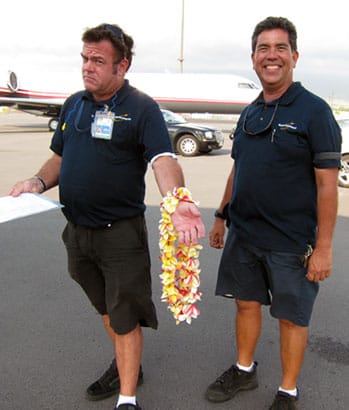
We arrived in Kona after an 8.8 hour flight, performing 8 slow dips from 28,000 to 1,000 feet and ascending back up. On the way to Cold Bay, Alaska and for the next two hours after Cold Bay we did not see anything but clouds. Solid decks, stacked at two levels and sometimes at three precluded us from seeing anything other than each other in the cabin. We ate two lunches just to kill the time – who can wonder why I gain 8 pounds each on campaigns like this? For the last 5 hours we flew over the open ocean, which was moderately choppy. Several bow-shaped weather fronts outlined by clouds spanned the vast expanse of water, with some corresponding calmer and rougher seas underneath.
We approached the Big Island from the North Eastern side, which enjoyed the rare case of nice sunny weather at the time. We flew North of Mauna Kea, about level with its top, so that the observatory buildings on its top were clearly visible. Mauna Loa and Mauna Kea are fairly flat volcanoes whose slopes are covered in meandering lava flows of varying ages, some covered with sparse vegetation and some pretty barren. The two mountains are formed from basalt lava, which has low viscosity and caused the mountains to be very widely spread and look not so tall in comparison with their length and width, but one should remember that they are over 13,000 feet high and it snows on their tops. Snow in Hawaii – it does happen.

We landed in Kona at about 4:30 PM and were met by the friendly staff from Airservice Hawaii. Red carpet and leis that the fine folks met us with were a very nice touch that I don’t think I will ever stop noticing, even though they keep doing this time and time again. The four rental cars were already positioned by the plane side and we were able to go to the hotel as soon as we were finished with work without any delays or hassles. Air Service Hawaii is a pleasure to work with and I will call them any time I need help with anything in Kona.
The Kona side of the island was covered by “vog” – fog of volcanic origin, condensing of the ultrafine volcanic particles, sulfuric aerosols, steam and salt that are lifted in the air at the places where the lava enters the ocean on the South East side of the island. Shadowed by Mauna Loa from the prevailing easterly winds, Kona is nearly always hazy but, as a flip side of the same coin, nearly always sunny. I have only once or twice in several visits seen its air clear enough to provide for good landscape picture taking opportunities.